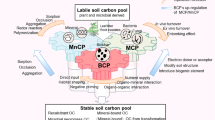Abstract
Bioturbation by termites is considered a key process in the regulation of soil properties in tropical soils. The concentration of clay and the presence of 2:1 clay minerals in termite soil are usually explained by the need for termites to build stable biogenic structures and/or to have access to water only available in the lower soil layers. However, while these hypotheses are attractive, they do not always offer a sufficient explanation for understanding termite bioturbation behavior. Here, we used ecological stoichiometry theory to propose a third hypothesis that bioturbation can also be explained by the limitation of termites for Na+. This chemical element is missing from the vegetation consumed by termites, while it plays an important role in the regulation of termites’ physiological processes. In old and highly weathered soils, such as those found in the tropics, a significant source of Na+ for termites likely comes from 2:1 minerals, which are only available in the deeper soil layers. Therefore, this article aims to propose the hypothesis of the use of bioturbation by termites as a means to fulfill their need for Na+. The impacts of this ecological process on ecosystem functioning and soil fertility are discussed.

Similar content being viewed by others
References
Bruand A, Reatto A, de Souza MÉ (2022) Allochthonous material originating from saprolite as a marker of termite activity in Ferralsols. Sci Rep 12:17193
Clay NA, Yanoviak SP, Kaspari M (2014) Short-term sodium inputs attract microbi-detritivores and their predators. Soil Biol Biochem 75:248–253
Higashi M, Abe T, Burns TP (1992) Carbon-nitrogen balance and termite ecology. Proc R Soc Lond B 249:303–308
Jouquet P, Bottinelli N, Shanbhag RR, Bourguignon T, Traoré S, Abbasi SA (2016) Termites: the neglected soil engineers of tropical soils. Soil Sci 181:157–165
Jouquet P, Jamoteau F, Majumdar S, Podwojewski P, Nagabovanalli P, Caner L, Barboni D, Meunier J-D (2020) The distribution of silicon in soil is influenced by termite bioturbation in South Indian forest soils. Geoderma 372:114362
Jouquet P, Traoré S, Choosai C, Hartmann C, Bignell D (2011) Influence of termites on ecosystem functioning. Ecosystem services provided by termites. Eur J Soil Biol 47:215–222
Kaspari M (2020) The seventh macronutrient: how sodium shortfall ramifies through populations, food webs and ecosystems. Ecol Lett 23:1153–1168
Kaspari M, Clay NA, Donoso DA, Yanoviak SP (2014) Sodium fertilization increases termites and enhances decomposition in an Amazonian forest. Ecology 95:795–800
Kaspari M, Yanoviak SP, Dudley R, Yuan M, Clay NA (2009) Sodium shortage as a constraint on the carbon cycle in an inland tropical rainforest. Proc Nat Ac Sci 106:19405–19409
Sanchez PA (2019) Properties and management of soils in the tropics. Press, Cambridge, UK
Scharnagl K, Scharnagl A, von Wettberg E (2017) Nature’s potato chip. Am J Bot 104:641–644
Yoshimura T, Kagemori N, Kawai S, Sera K, Futatsugawa S (2002) Trace elements in termites by PIXE analysis. Nucl Instrum Methods Phys Res B 189(1-4):450–453
Acknowledgements
As in any opinion paper, the concepts and ideas formulated in this article result from dialogs with many colleagues and peers, who are all acknowledged. We also thank the reviewers and the editor for their constructive remarks and significant help in improving the manuscript. Finally, we are grateful to Cristal Ricoy Martinez for the illustration and L. Ganesha for his unconditional support.
Author information
Authors and Affiliations
Corresponding author
Ethics declarations
Conflict of interest
The authors declare no competing interests.
Additional information
Publisher’s note
Springer Nature remains neutral with regard to jurisdictional claims in published maps and institutional affiliations.
Rights and permissions
Springer Nature or its licensor (e.g. a society or other partner) holds exclusive rights to this article under a publishing agreement with the author(s) or other rightsholder(s); author self-archiving of the accepted manuscript version of this article is solely governed by the terms of such publishing agreement and applicable law.
About this article
Cite this article
Jouquet, P., Bruand, A. Bioturbation as a means to circumvent sodium limitation by termites? Suspected processes and ecological consequences. Biol Fertil Soils 59, 567–570 (2023). https://doi.org/10.1007/s00374-023-01752-2
Received:
Revised:
Accepted:
Published:
Issue Date:
DOI: https://doi.org/10.1007/s00374-023-01752-2




